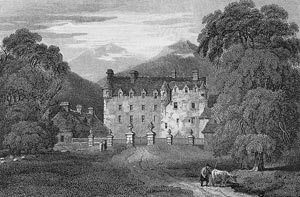History of the Stewarts | Castles and Buildings
If you are a Stewart Society Member please login above to view all of the items in this section. If you want general information on how to research your ancestors and some helpful links - please look in background information.
If you have a specific question you can contact our archivist.

Eventually the Borders became a little more settled and when James III succeeded in 1460, he gave Traquair to his current favourite Robert Lord Boyd, but when the gift was not appreciated he gave the castle to his favourite court musician, William Rogers. However, Rogers held Traquair for only nine years when he was persuaded to sell it to the Earl of Buchan for the insignificant amount of 70 Scots merks (£3 15s).
The Earl gave the estate to his illegitimate son, James Stuart (1480-1513), 1st Laird of Traquair, in 1491. James Stuart obtained letters of legitimation, and married the heiress of the Rutherfords, with whom he received the estates of Rutherford and Wells in Roxburghshire. Stuart was killed at the Battle of Flodden. His daughter, Lady Jane Stuart, became involved with the married Earl of Angus, by whom she had a daughter out of wedlock, Lady Janet Douglas (d.1552). Janet married Patrick Ruthven, 3rd Lord Ruthven and produced several children During the 1500’s and 1600’s the main building was completed and ithe lairds of Traquair played important roles in public life with John Stuart, 4th Laird of Traquair becoming the Captain of the Queen´s bodyguard to Mary Queen of Scots. He was host to the Queen when she visited Traquair with her husband and baby son James in 1566
However, in the mid 1600’s the family returned to the Catholic faith, thereby forfeiting any further chance of advancement and their later support for the Jacobite cause increase their isolation. The seventh Laird also became the most influential member of the family and he held the post of Lord High Treasurer of Scotland. He was granted an earldom in 1628 and three years later became Commissioner of Scotland. Unfortunately his fidelity to the king and his attempt to bring Episcopacy to Scotland were to be his downfall. The Catholic tradition which has remained in the house to this day was established by John, second Earl of Traquair. His second wife, Lady Anne Seton was a strong Catholic and despite the dangers of the day was determined to bring her five children up as Catholics. Mass was said in secret in a small chamber on the top floor. A secret escape route for the priest was hidden behind a concealed cupboard and led down the old stairs. It continued to be used until the Catholic Emancipation Act in 1828.
The two wings were added in 1694 and these were the last additions to the house with the exception of the famous Bear Gates at the top of the main drive which were built in 1739 only to be closed in 1745 following the visit of Bonnie Prince Charlie when supposedly the 5th Earl promised they would never be opened again until the Stuarts returned to the throne.
The Stuarts survived at Traquair until 1875 when Lady Louisa Stuart died unmarried. The earldom was lost as it had to passed through the male line and the house passed to her cousin Henry Constable Maxwell who took the name Maxwell Stuart and it is Catherine Maxwell Stuart, 21st Lady of Traquair, who lives with her family in the house today.

